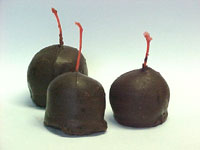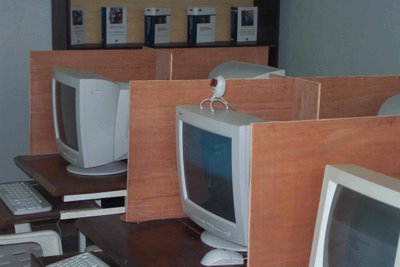plannerliness
a take on life|work by a few plannerly types
5/31/2006
pearl jam
 Went and saw these guys last night and they put on a great show, it's something I've been hoping to have the chance to do for several years. It's obvious they love being up on stage, something the younger indie bands could learn from.
Went and saw these guys last night and they put on a great show, it's something I've been hoping to have the chance to do for several years. It's obvious they love being up on stage, something the younger indie bands could learn from.Mike McCready was a madman on guitar, romping around the stage, doing the "Alive" solo with what looked like his teeth. They even did an unplugged set where Eddie Vedder's voice was able to really shine.
Two things that struck me at the show were the availability of bootlegs and the number of teens and tweens. Maybe I'm late to the game on the bootleg idea, but it's brilliant -- direct fans to a website where they can download an mp3 of the show in a couple of days. I remember seeing shows growing up and just hoping that the band would release a live album from THAT venue and date, but thankfully the record companies lost that battle.
The generation-span of Pearl Jam was pretty apparent, as a lot of "grups" were there as old as 50, along with an army of 12-15 year-olds. Some of them looked like they weren't born until after the release of "Vs." in 1993, so it looks like they are set to become a Neil Young/U2-esque group that most rock fans enjoy, something that would have been hard to see coming based on their angst-ridden early years.
The band is also doing all the right things in the new media world to be relevant to the younger generation, from recording Sessions @ AOL to releasing the "Life Wasted" video with a Creative Commons license. And check out this satire of the band's willingness to play nice with Ticketmaster.
5/25/2006
kermit

The Muppets are never going to get old for me. Now to relate this to planning, if the doctor symbolizes the client and Kermit is the work, guess that makes planners the x-ray machine. Does that make sense?
5/23/2006
martha stewart social network
 Martha Stewart is planning a social network as part of her marthastewart.com web site, aimed at 25-45 year-old women. It's a tool that will allow for photos, scrapbook tips, recipes, and other ideas to be shared among members.
Martha Stewart is planning a social network as part of her marthastewart.com web site, aimed at 25-45 year-old women. It's a tool that will allow for photos, scrapbook tips, recipes, and other ideas to be shared among members."'There is no place like MySpace, like Friendster, for that demographic,' [Chief Executive Susan] Lyne said at a financial conference."
The site won't be launched until over a year from now - and a lot could change between now and then, including a mySpace geared towards older women. Or a new magazine launch.
It will be interesting to see how the site does, as it looks like it's just going to be an extension of the current website. From the description, it sounds like they are trying to take the mainstream media ways and swim in the new web. Some of my relatives fall into that 25-45 demographic, and it's going to take a lot more than Martha Stewart putting her name on this kind of thing to get them to use it.
online country club
 It seems like every week a new social networking site climbs out of the woodwork and into the news, usually with 100,000+ users already in tow. This time it was the site aSmallWorld, who just received an investment from movie moguls Bob and Harvey Weinstein.
It seems like every week a new social networking site climbs out of the woodwork and into the news, usually with 100,000+ users already in tow. This time it was the site aSmallWorld, who just received an investment from movie moguls Bob and Harvey Weinstein. At least the site is upfront about it's country club atmosphere:
At least the site is upfront about it's country club atmosphere:"We have imposed certain criteria in order to keep the network private and exclusive. To join, you need to be invited by a trusted member. If you have not received an invitation, you can ask your friends to invite you. If you have no friends who are members yet, you simply need to be patient."
Exclusivity in a world of 75 million mySpace users... what a great differentiator.
5/22/2006
there goes the day
Music videos never lose their luster. It's simple storytelling at its best - the director is given 4 minutes and a song to work his magic. It almost always turns out halfway decent. This guy created an archive of all 80s music videos, and I'll be lucky to get 15 minutes of work done today.
Via Ypulse
5/15/2006
the red pill, part 2

The real and virtual worlds continue to collide - take a look at this, a BBC Radio 1 real-life and Second Life festival, that took place simultaneously over the weekend.
via Wonderland.
5/12/2006
999 design classics
 Phaidon Press is at it again - they released this inspirational set of books about a month ago. It's a chronological journey through beautifully-designed objects that we still use - everything from toys to medical stuff to cars, starting with household scissors (1663).
Phaidon Press is at it again - they released this inspirational set of books about a month ago. It's a chronological journey through beautifully-designed objects that we still use - everything from toys to medical stuff to cars, starting with household scissors (1663).It's interesting to get this historical perspective on design. If the safety pin hadn't been invented in 1849 by Walter Hunt, who knows if to this day we'd still be waiting for it. If you don't have the funds (like me) for the full-fledged set, check out the site (click "Explore...") and get a taste.
5/11/2006
bonds needs a brand strategy
 What can be done to save Barry Bonds and his pursuit of the the all-time home run record? As Tom Verducci of SI states, it has truly become a "joyless endeavor", one that is painful to watch as a lifelong baseball fan.
What can be done to save Barry Bonds and his pursuit of the the all-time home run record? As Tom Verducci of SI states, it has truly become a "joyless endeavor", one that is painful to watch as a lifelong baseball fan.It's not because I'm upset at Bonds, but it's more like the feeling you get after wrongly asking the "are you pregnant?" question, the awkwardness surrounding the whole thing is getting to be unbearable.
Short of a time machine taking us back to the pre-'roids era, what could Bonds possibly do to get himself out of this? Is it too late? To add to the problem, he only has until #756 to change how the masses view him...
5/09/2006
economist survey
From the late April edition of The Economist, a survey of new media that should help anyone who hasn't really been paying attention until now figure out the new web trends. The summary of new media issues is partially old news, but any time I read something on the so-called media revolution I get one more example of something I didn't know before.
This time it was of the site Ohmy news, founded by a South Korean ex-magazine editor. Ohmy only allows amateurs ("citizens") to write in and a small group of editors choose which articles to put on the site. The coolest thing about it is a tip-jar button that asks readers to donate a small amount if they like the writing - I couldn't find this feature on the English site, it must be a South Korean-only thing.
In addition to the intro and outro, here are the key articles:
blogs
interactive journalism (Ohmy)
wikis
podcasts
fantasy worlds (Second Life)
ends with, the "gazillion-dollar question" - what is the new media company?
great list of sources
The best quote out of all the articles comes from Paul Saffo, a director at the Institute for the Future:
“revolutions tend to suck for ordinary people.”
5/08/2006
planning and pop songs
 Painting a vivid picture of people in as few words as possible is something we're expected to do, and it's also something that songwriters have to keep in mind. There's only so many words that will fit into a 4-minute rock/pop song.
Painting a vivid picture of people in as few words as possible is something we're expected to do, and it's also something that songwriters have to keep in mind. There's only so many words that will fit into a 4-minute rock/pop song.While on a road trip over the weekend I heard Gavin DeGraw's song "Chariot" for the first time in awhile, and one 16-word line from the beginning of the song provides a perfect example. After hearing these few words, I have a crystal clear mental image of who he's singing to:
"Your favorite fruit is chocolate covered cherries...
Seedless watermelon...
Nothing from the ground is good enough."
5/02/2006
testing center design
All this recent talk on the web about creative spaces has put the topic in the back of my mind over the last few weeks. I just ran across this article on how testing center environments can hinder test scores on standardized tests like the LSAT and MCAT. I took my grad entrance exam in a place that looks like this:

...and I did feel a little cramped, both physically and mentally, by the stale environment. The Kaplan study the article refers to takes into account more rational things like "...amount of desk space, quiet and comfort of site, usefulness of proctors, and overall site experience."
I hope that eventually students will have the option to take a standardized test that adds in some more things to make the testing environment more emotionally comfortable as well. Not exactly sure how this would be done, but each city could have a few different options for environments that students thrive in - test centers designed like coffee shops, libraries, parks, etc. When students sign up for the test, they just pick the environment they want to be in.

The big problem here is that these test centers are just milking the money - they have virtually no incentive to change. It's like an old ragged apartment in a coveted part of a city that the landlord probably should fix, but he doesn't have to fix anything in order to keep the rent checks coming.




